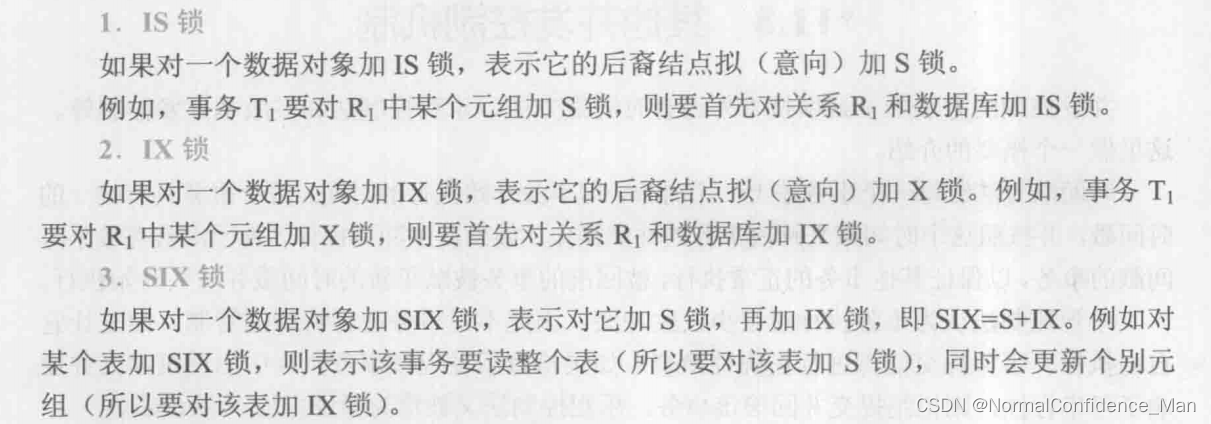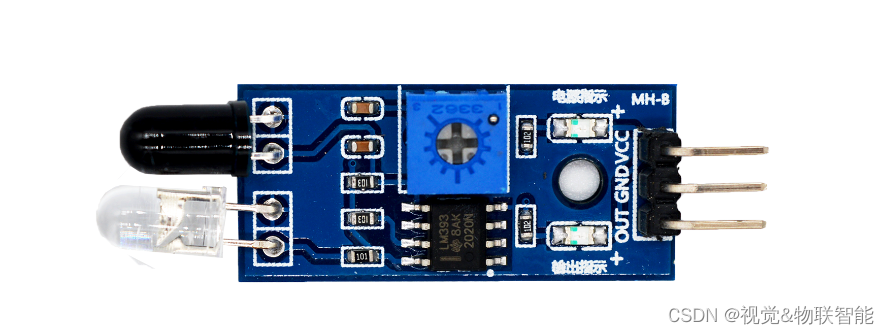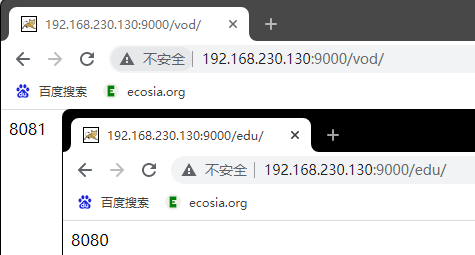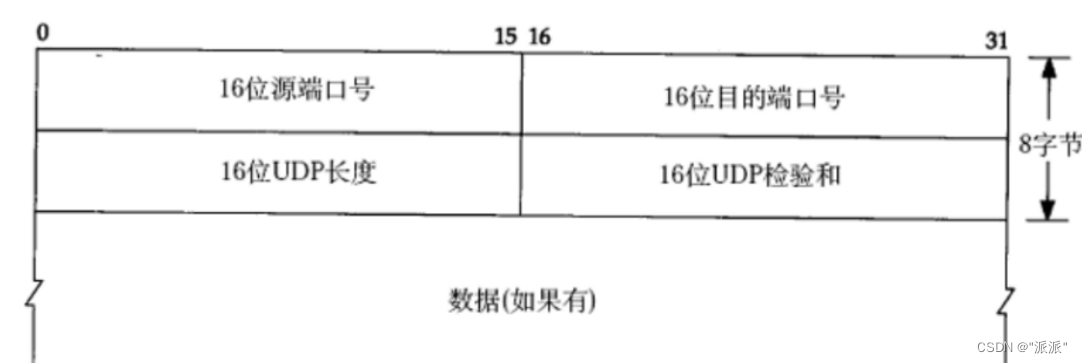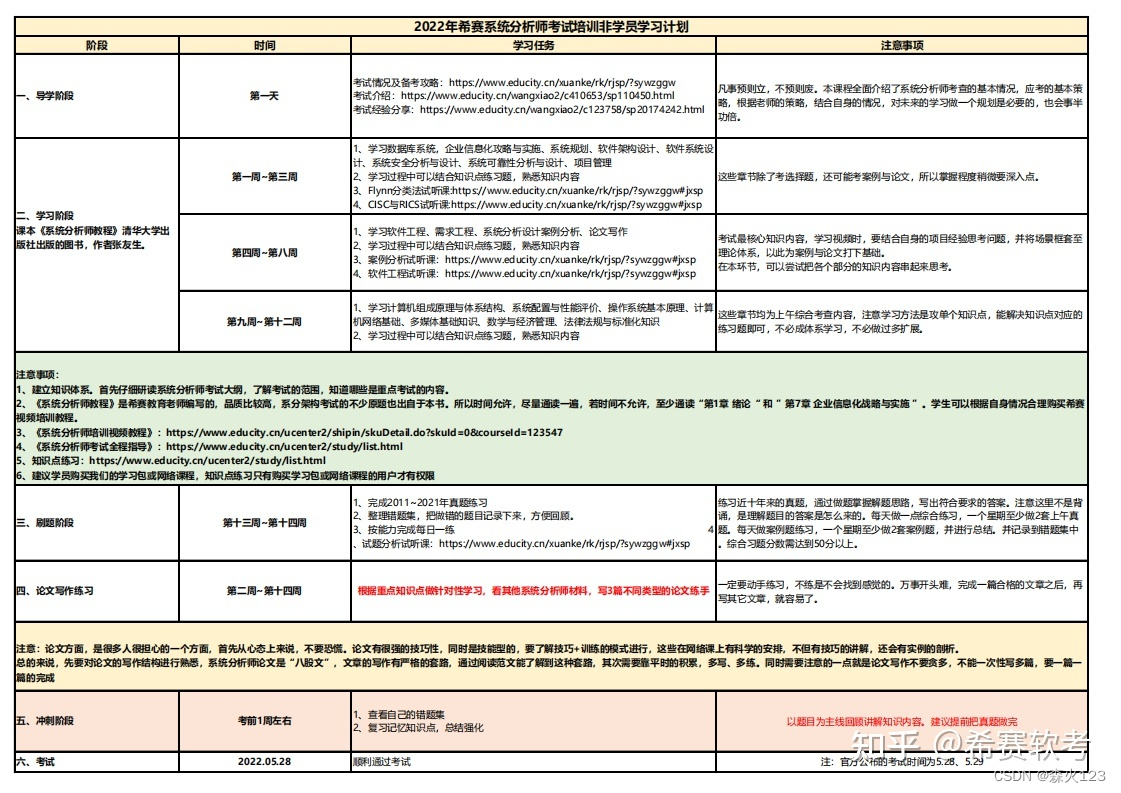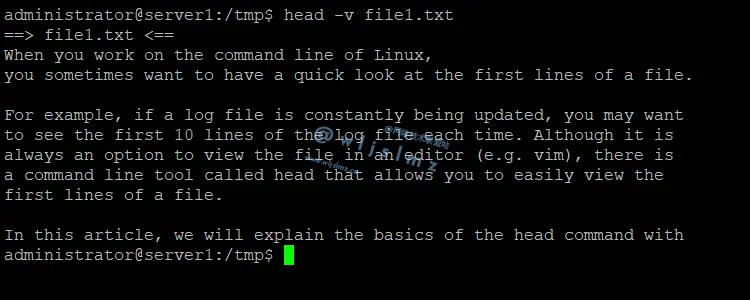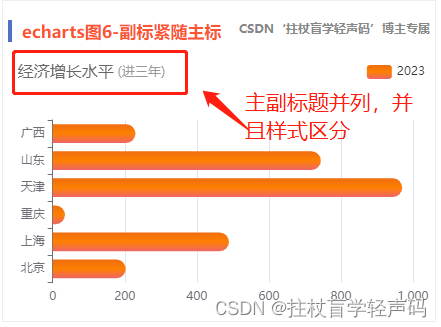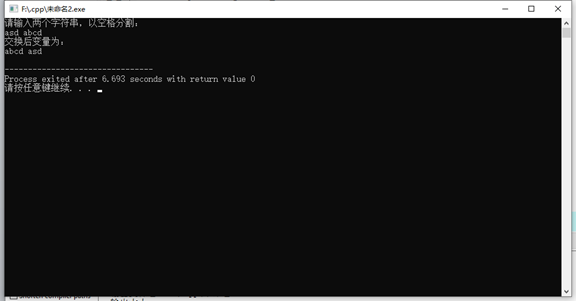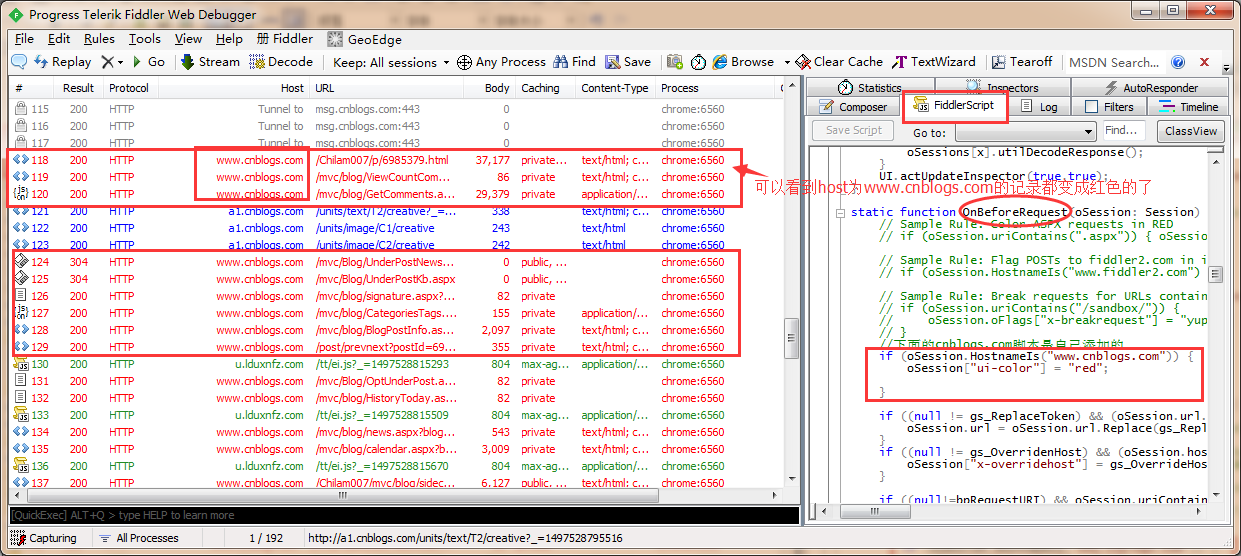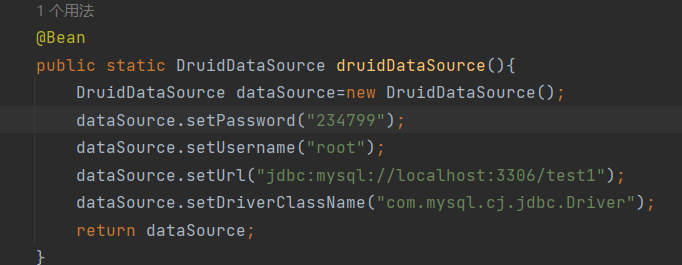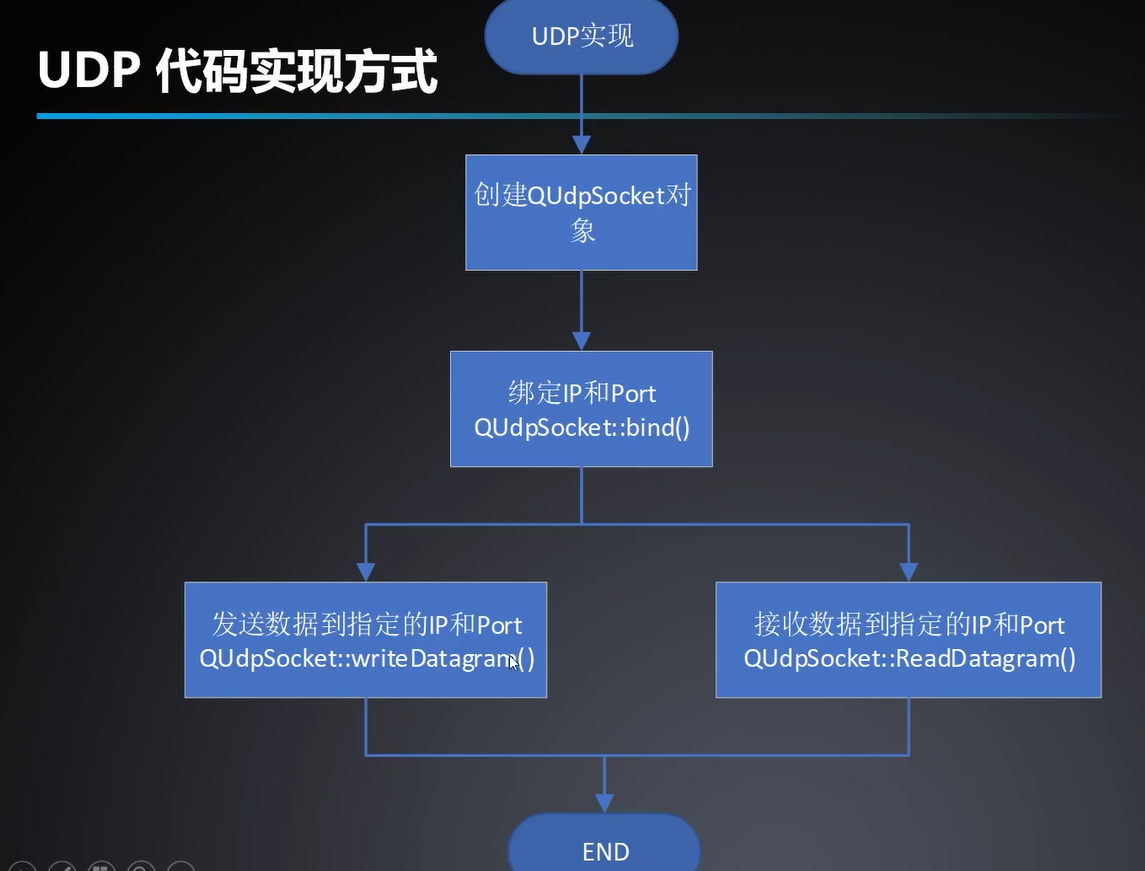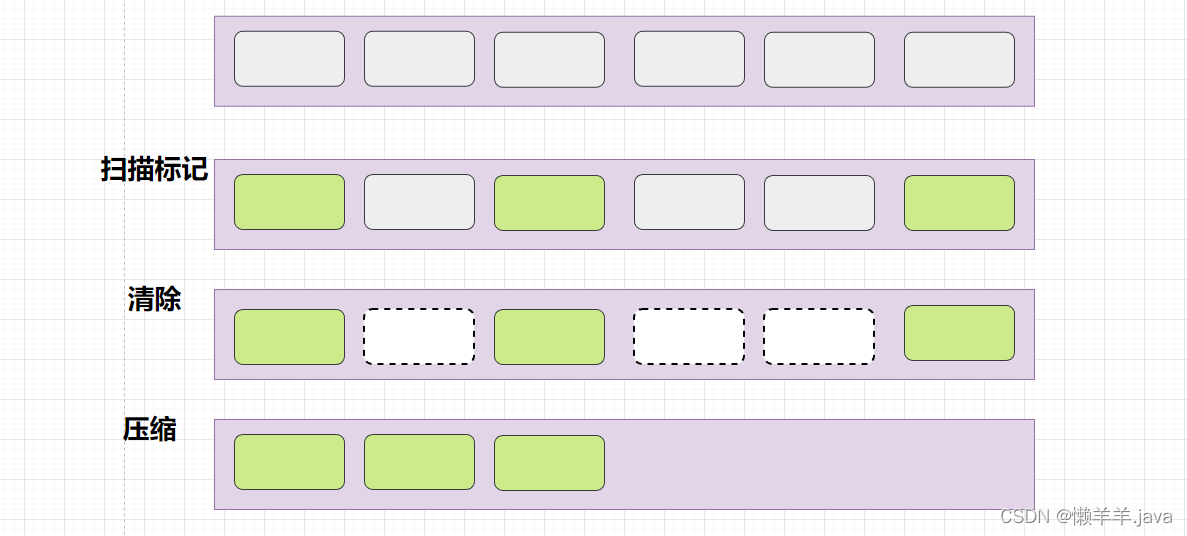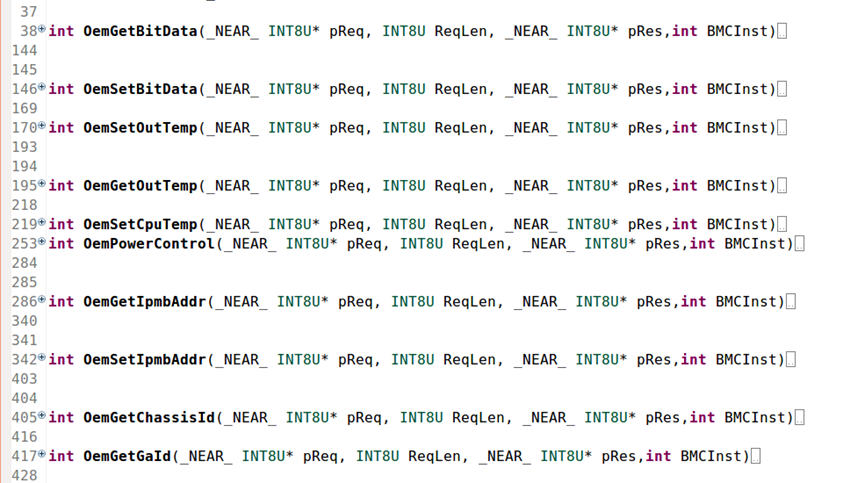一: 前言
我们尝试在前几篇文章的内容中串联起来,防止各位不知所云。
1:背景
我们基于Mybatis作为后台Orm框架进行编码的时候,有两种方式。
//编码方式1
UserDao userDao = sqlSession.getMapper(UserDao.class);
userDao.queryAllUser(Map map);
//有同学质疑为毛我从来没有sqlSesseion.getMapper(..)是因为我们使用Spring或者
//boot的时候右边给你封装了,导致你直接在Service里边把UserDao进行了注入,直接
//=右边的,你可能压根就没有机会写。
//编码方式2
sqlSession.select("com.shit.user.UserDao.queryAllUser",Map map);
我们提到了,最为底层的是下边这种方式,第一种方式是基于动态代理的技术实现的,底层也是第二种方式,基于此我们开始探索了动态代理的这种方式,整套流程下来是怎么玩的。
UserDao userDao = SqlSession.getMapper(User.class)
userDao.queryuserById();
userDao.queryUsers();
2:代理设计模式(动态代理)的一些特点(简述)
这里的userDao是DAO接口的实现类的对象,那么我们就会有一个疑问,UserDao这个接口实现类在哪里呢?
这个Dao接口的实现类我们是见不到的,因为这里是一个典型的动态字节码技术,这个类是在虚拟机当中运行时创建的。虚拟机运行结束的时候,这个类就消失了
这和我们之前的这些类不一样,我们之前写的这些类就是实实在在的文件,在我们的硬盘当中,通过JVM的类加载的方式读到虚拟机的内存当中。这是我们传统意义上的一个类的创建的方式,通过复杂的类加载机制将这个类加载到JVM虚拟机当中之后,我们在这个类的Class对象创建出来。
动态字节码技术的特点是类的文件自始至终就没有,直接就在虚拟机当中的内存当中去创建,进而创建这个类的Class对象。是JVM在运行时的时候基于动态字节码技术将这个类创建出来的操作。
这就是为什么我们知道有这么一个类的存在,有这么一个类的对象的存在,但是我们就看不到的原因。
创建完成之后,就按照多态的特点,代理对象地址保存在这个接口的引用类型下边。按照多态的原则,所以,我们才可以有这个效果。
3:使用代理设计模式场景
1):为原始对象(目标)增加额外功能
ps:如果是和原始功能没有半毛钱关系的内容才叫做额外功能,与原始功能有关系的功能就不太算是额外功能了,这种情况下推进使用装饰器模式。
这个场景典型的Spring的AOP的功能。
2):远程代理(远程代理)
ps:远程代理:这时候额外功能就变成1:网络连接:2:数据传输嘛。这个最典型的就是Dubbo,远程代理代理的是远程服务。
3):无中生有(只有接口,除了接口毛都没有)
ps:这个最符合的就是Mybatis的Dao层的实现类的处理了。接口实现类这个东西,我们真的看不见,但是运行时确实可以体现出来。
在这三个场景下,我们需要考虑用到代理设计模式,第三种是典型的动态代理。而动态代理的典型的编码是:
Proxy.newProxyInstance(AssistantToHistoryPriceRule.class.getClassLoader(),new Class[]{BillSystemConfigGateWay.class}, new InvocationHandler(){
@Override
public Object invoke(Object proxy, Method method, Object[] args) throws Throwable {
System.out.println("额外功能输出......");
return null;
}
});
二:实现类该如何去实现预定的功能呢?
1:猜想Mybatis的代理流程
我们现在有一个Ineterface接口中有这样的一个方法,实现类实现之后应该大致张这个样子:
以下这个是我们的大致流程猜想,当然最终结果肯定是与Mybatis的具体实现大差不差的。
interface UserDao{
List<User> queryAllUsers();
save(User user)
}
UserDaoImpl implements UserDAO {
queryAllUsers(){
sqlSession.select(....);
}
save(){
sqlSession.insert("namespace.id",参数);
}
}
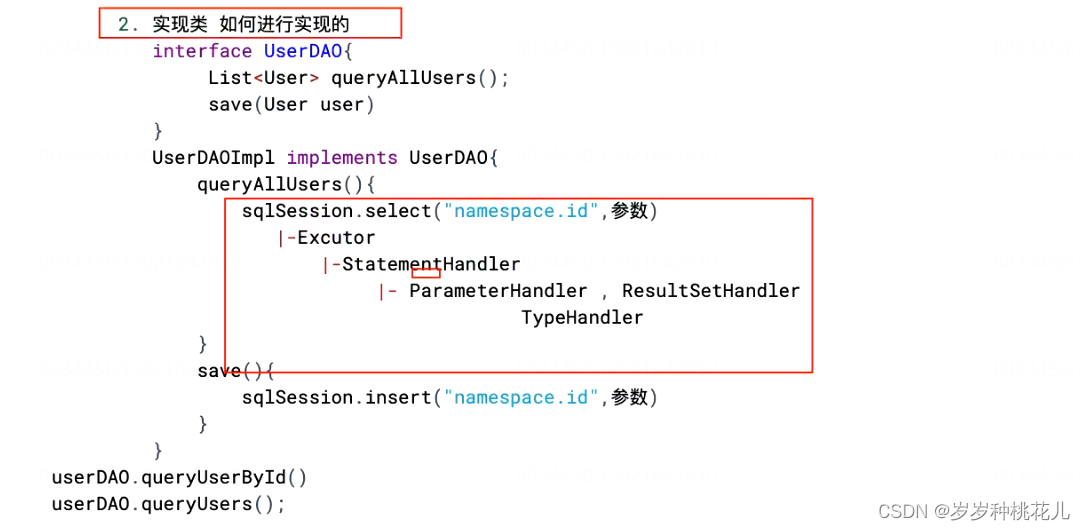
类加载器,接口,额外功能处理Handler三个条件满足之后,运行时会把这个代理对象给创建出来。
2:模拟Mybatis代理对象创建
@Test
public void testProxy() throws IOException {
InputStream inputStream = Resources.getResourceAsStream("mybatis-config.xml");
SqlSessionFactory sqlSessionFactory = new SqlSessionFactoryBuilder().build(inputStream);
SqlSession sqlSession = sqlSessionFactory.openSession();
Class[] interfaces = new Class[]{UserDAO.class};
UserDAO userDAO = (UserDAO) Proxy.newProxyInstance(TestMybatis.class.getClassLoader(),interfaces
,new MyMapperProxy(sqlSession,UserDAO.class));
List<User> users = userDAO.queryAllUsersByPage();
for (User user : users) {
System.out.println("user = " + user);
}
}
public class MyMapperProxy implements InvocationHandler {
private SqlSession sqlSession;
private Class daoClass;
public MyMapperProxy(SqlSession sqlSession, Class daoClass) {
this.sqlSession = sqlSession;
this.daoClass = daoClass;
}
@Override
public Object invoke(Object proxy, Method method, Object[] args) throws Throwable {
System.out.println(daoClass.getName() + "." + method.getName());
return sqlSession.selectList(daoClass.getName() + "." + method.getName());
}
}
这一步的创建代理的操作就等同于我们之前当中的SqlSession.getMapper(UserDao.class)的操作。

三:Mybatis代理对象创建的源码如下
Mybatis当中完成代理创建的核心类型是:MapperProxy和MapperProcyFactory
MapperProcyFactory:是个工厂,他的作用就是创建代理,工厂底层设计的过程中完成的就是Proxy.newProxyInstance(),为我们创建代理对象
MapperProxy:实现了InvocationHandler接口,他就是用调用具体method的。
/**
* @author Lasse Voss
*/
public class MapperProxyFactory<T> {
private final Class<T> mapperInterface;
private final Map<Method, MapperMethod> methodCache = new ConcurrentHashMap<Method, MapperMethod>();
public MapperProxyFactory(Class<T> mapperInterface) {
this.mapperInterface = mapperInterface;
}
public Class<T> getMapperInterface() {
return mapperInterface;
}
public Map<Method, MapperMethod> getMethodCache() {
return methodCache;
}
@SuppressWarnings("unchecked")
protected T newInstance(MapperProxy<T> mapperProxy) {
return (T) Proxy.newProxyInstance(mapperInterface.getClassLoader(), new Class[] { mapperInterface }, mapperProxy);
}
public T newInstance(SqlSession sqlSession) {
final MapperProxy<T> mapperProxy = new MapperProxy<T>(sqlSession, mapperInterface, methodCache);
return newInstance(mapperProxy);
}
}
/**
* @author Clinton Begin
* @author Eduardo Macarron
*/
public class MapperProxy<T> implements InvocationHandler, Serializable {
private static final long serialVersionUID = -6424540398559729838L;
private final SqlSession sqlSession;
private final Class<T> mapperInterface;
private final Map<Method, MapperMethod> methodCache;
public MapperProxy(SqlSession sqlSession, Class<T> mapperInterface, Map<Method, MapperMethod> methodCache) {
this.sqlSession = sqlSession;
this.mapperInterface = mapperInterface;
this.methodCache = methodCache;
}
@Override
public Object invoke(Object proxy, Method method, Object[] args) throws Throwable {
try {
if (Object.class.equals(method.getDeclaringClass())) {
return method.invoke(this, args);
} else if (isDefaultMethod(method)) {
return invokeDefaultMethod(proxy, method, args);
}
} catch (Throwable t) {
throw ExceptionUtil.unwrapThrowable(t);
}
final MapperMethod mapperMethod = cachedMapperMethod(method);
return mapperMethod.execute(sqlSession, args);
}
private MapperMethod cachedMapperMethod(Method method) {
MapperMethod mapperMethod = methodCache.get(method);
if (mapperMethod == null) {
mapperMethod = new MapperMethod(mapperInterface, method, sqlSession.getConfiguration());
methodCache.put(method, mapperMethod);
}
return mapperMethod;
}
@UsesJava7
private Object invokeDefaultMethod(Object proxy, Method method, Object[] args)
throws Throwable {
final Constructor<MethodHandles.Lookup> constructor = MethodHandles.Lookup.class
.getDeclaredConstructor(Class.class, int.class);
if (!constructor.isAccessible()) {
constructor.setAccessible(true);
}
final Class<?> declaringClass = method.getDeclaringClass();
return constructor
.newInstance(declaringClass,
MethodHandles.Lookup.PRIVATE | MethodHandles.Lookup.PROTECTED
| MethodHandles.Lookup.PACKAGE | MethodHandles.Lookup.PUBLIC)
.unreflectSpecial(method, declaringClass).bindTo(proxy).invokeWithArguments(args);
}
/**
* Backport of java.lang.reflect.Method#isDefault()
*/
private boolean isDefaultMethod(Method method) {
return (method.getModifiers()
& (Modifier.ABSTRACT | Modifier.PUBLIC | Modifier.STATIC)) == Modifier.PUBLIC
&& method.getDeclaringClass().isInterface();
}
}
public class MapperMethod {
private final SqlCommand command;
private final MethodSignature method;
public MapperMethod(Class<?> mapperInterface, Method method, Configuration config) {
this.command = new SqlCommand(config, mapperInterface, method);
this.method = new MethodSignature(config, mapperInterface, method);
}
public Object execute(SqlSession sqlSession, Object[] args) {
Object result;
switch (command.getType()) {
case INSERT: {
Object param = method.convertArgsToSqlCommandParam(args);
result = rowCountResult(sqlSession.insert(command.getName(), param));
break;
}
case UPDATE: {
Object param = method.convertArgsToSqlCommandParam(args);
result = rowCountResult(sqlSession.update(command.getName(), param));
break;
}
case DELETE: {
Object param = method.convertArgsToSqlCommandParam(args);
result = rowCountResult(sqlSession.delete(command.getName(), param));
break;
}
case SELECT:
if (method.returnsVoid() && method.hasResultHandler()) {
executeWithResultHandler(sqlSession, args);
result = null;
} else if (method.returnsMany()) {
result = executeForMany(sqlSession, args);
} else if (method.returnsMap()) {
result = executeForMap(sqlSession, args);
} else if (method.returnsCursor()) {
result = executeForCursor(sqlSession, args);
} else {
Object param = method.convertArgsToSqlCommandParam(args);
result = sqlSession.selectOne(command.getName(), param);
}
break;
case FLUSH:
result = sqlSession.flushStatements();
break;
default:
throw new BindingException("Unknown execution method for: " + command.getName());
}
if (result == null && method.getReturnType().isPrimitive() && !method.returnsVoid()) {
throw new BindingException("Mapper method '" + command.getName()
+ " attempted to return null from a method with a primitive return type (" + method.getReturnType() + ").");
}
return result;
}
private Object rowCountResult(int rowCount) {
final Object result;
if (method.returnsVoid()) {
result = null;
} else if (Integer.class.equals(method.getReturnType()) || Integer.TYPE.equals(method.getReturnType())) {
result = rowCount;
} else if (Long.class.equals(method.getReturnType()) || Long.TYPE.equals(method.getReturnType())) {
result = (long)rowCount;
} else if (Boolean.class.equals(method.getReturnType()) || Boolean.TYPE.equals(method.getReturnType())) {
result = rowCount > 0;
} else {
throw new BindingException("Mapper method '" + command.getName() + "' has an unsupported return type: " + method.getReturnType());
}
return result;
}
private void executeWithResultHandler(SqlSession sqlSession, Object[] args) {
MappedStatement ms = sqlSession.getConfiguration().getMappedStatement(command.getName());
if (!StatementType.CALLABLE.equals(ms.getStatementType())
&& void.class.equals(ms.getResultMaps().get(0).getType())) {
throw new BindingException("method " + command.getName()
+ " needs either a @ResultMap annotation, a @ResultType annotation,"
+ " or a resultType attribute in XML so a ResultHandler can be used as a parameter.");
}
Object param = method.convertArgsToSqlCommandParam(args);
if (method.hasRowBounds()) {
RowBounds rowBounds = method.extractRowBounds(args);
sqlSession.select(command.getName(), param, rowBounds, method.extractResultHandler(args));
} else {
sqlSession.select(command.getName(), param, method.extractResultHandler(args));
}
}
private <E> Object executeForMany(SqlSession sqlSession, Object[] args) {
List<E> result;
Object param = method.convertArgsToSqlCommandParam(args);
if (method.hasRowBounds()) {
RowBounds rowBounds = method.extractRowBounds(args);
result = sqlSession.<E>selectList(command.getName(), param, rowBounds);
} else {
result = sqlSession.<E>selectList(command.getName(), param);
}
// issue #510 Collections & arrays support
if (!method.getReturnType().isAssignableFrom(result.getClass())) {
if (method.getReturnType().isArray()) {
return convertToArray(result);
} else {
return convertToDeclaredCollection(sqlSession.getConfiguration(), result);
}
}
return result;
}
private <T> Cursor<T> executeForCursor(SqlSession sqlSession, Object[] args) {
Cursor<T> result;
Object param = method.convertArgsToSqlCommandParam(args);
if (method.hasRowBounds()) {
RowBounds rowBounds = method.extractRowBounds(args);
result = sqlSession.<T>selectCursor(command.getName(), param, rowBounds);
} else {
result = sqlSession.<T>selectCursor(command.getName(), param);
}
return result;
}
private <E> Object convertToDeclaredCollection(Configuration config, List<E> list) {
Object collection = config.getObjectFactory().create(method.getReturnType());
MetaObject metaObject = config.newMetaObject(collection);
metaObject.addAll(list);
return collection;
}
@SuppressWarnings("unchecked")
private <E> Object convertToArray(List<E> list) {
Class<?> arrayComponentType = method.getReturnType().getComponentType();
Object array = Array.newInstance(arrayComponentType, list.size());
if (arrayComponentType.isPrimitive()) {
for (int i = 0; i < list.size(); i++) {
Array.set(array, i, list.get(i));
}
return array;
} else {
return list.toArray((E[])array);
}
}
private <K, V> Map<K, V> executeForMap(SqlSession sqlSession, Object[] args) {
Map<K, V> result;
Object param = method.convertArgsToSqlCommandParam(args);
if (method.hasRowBounds()) {
RowBounds rowBounds = method.extractRowBounds(args);
result = sqlSession.<K, V>selectMap(command.getName(), param, method.getMapKey(), rowBounds);
} else {
result = sqlSession.<K, V>selectMap(command.getName(), param, method.getMapKey());
}
return result;
}
public static class ParamMap<V> extends HashMap<String, V> {
private static final long serialVersionUID = -2212268410512043556L;
@Override
public V get(Object key) {
if (!super.containsKey(key)) {
throw new BindingException("Parameter '" + key + "' not found. Available parameters are " + keySet());
}
return super.get(key);
}
}
public static class SqlCommand {
private final String name;
private final SqlCommandType type;
public SqlCommand(Configuration configuration, Class<?> mapperInterface, Method method) {
final String methodName = method.getName();
final Class<?> declaringClass = method.getDeclaringClass();
MappedStatement ms = resolveMappedStatement(mapperInterface, methodName, declaringClass,
configuration);
if (ms == null) {
if (method.getAnnotation(Flush.class) != null) {
name = null;
type = SqlCommandType.FLUSH;
} else {
throw new BindingException("Invalid bound statement (not found): "
+ mapperInterface.getName() + "." + methodName);
}
} else {
name = ms.getId();
type = ms.getSqlCommandType();
if (type == SqlCommandType.UNKNOWN) {
throw new BindingException("Unknown execution method for: " + name);
}
}
}
public String getName() {
return name;
}
public SqlCommandType getType() {
return type;
}
private MappedStatement resolveMappedStatement(Class<?> mapperInterface, String methodName,
Class<?> declaringClass, Configuration configuration) {
String statementId = mapperInterface.getName() + "." + methodName;
if (configuration.hasStatement(statementId)) {
return configuration.getMappedStatement(statementId);
} else if (mapperInterface.equals(declaringClass)) {
return null;
}
for (Class<?> superInterface : mapperInterface.getInterfaces()) {
if (declaringClass.isAssignableFrom(superInterface)) {
MappedStatement ms = resolveMappedStatement(superInterface, methodName,
declaringClass, configuration);
if (ms != null) {
return ms;
}
}
}
return null;
}
}
public static class MethodSignature {
private final boolean returnsMany;
private final boolean returnsMap;
private final boolean returnsVoid;
private final boolean returnsCursor;
private final Class<?> returnType;
private final String mapKey;
private final Integer resultHandlerIndex;
private final Integer rowBoundsIndex;
private final ParamNameResolver paramNameResolver;
public MethodSignature(Configuration configuration, Class<?> mapperInterface, Method method) {
Type resolvedReturnType = TypeParameterResolver.resolveReturnType(method, mapperInterface);
if (resolvedReturnType instanceof Class<?>) {
this.returnType = (Class<?>) resolvedReturnType;
} else if (resolvedReturnType instanceof ParameterizedType) {
this.returnType = (Class<?>) ((ParameterizedType) resolvedReturnType).getRawType();
} else {
this.returnType = method.getReturnType();
}
this.returnsVoid = void.class.equals(this.returnType);
this.returnsMany = configuration.getObjectFactory().isCollection(this.returnType) || this.returnType.isArray();
this.returnsCursor = Cursor.class.equals(this.returnType);
this.mapKey = getMapKey(method);
this.returnsMap = this.mapKey != null;
this.rowBoundsIndex = getUniqueParamIndex(method, RowBounds.class);
this.resultHandlerIndex = getUniqueParamIndex(method, ResultHandler.class);
this.paramNameResolver = new ParamNameResolver(configuration, method);
}
public Object convertArgsToSqlCommandParam(Object[] args) {
return paramNameResolver.getNamedParams(args);
}
public boolean hasRowBounds() {
return rowBoundsIndex != null;
}
public RowBounds extractRowBounds(Object[] args) {
return hasRowBounds() ? (RowBounds) args[rowBoundsIndex] : null;
}
public boolean hasResultHandler() {
return resultHandlerIndex != null;
}
public ResultHandler extractResultHandler(Object[] args) {
return hasResultHandler() ? (ResultHandler) args[resultHandlerIndex] : null;
}
public String getMapKey() {
return mapKey;
}
public Class<?> getReturnType() {
return returnType;
}
public boolean returnsMany() {
return returnsMany;
}
public boolean returnsMap() {
return returnsMap;
}
public boolean returnsVoid() {
return returnsVoid;
}
public boolean returnsCursor() {
return returnsCursor;
}
private Integer getUniqueParamIndex(Method method, Class<?> paramType) {
Integer index = null;
final Class<?>[] argTypes = method.getParameterTypes();
for (int i = 0; i < argTypes.length; i++) {
if (paramType.isAssignableFrom(argTypes[i])) {
if (index == null) {
index = i;
} else {
throw new BindingException(method.getName() + " cannot have multiple " + paramType.getSimpleName() + " parameters");
}
}
}
return index;
}
private String getMapKey(Method method) {
String mapKey = null;
if (Map.class.isAssignableFrom(method.getReturnType())) {
final MapKey mapKeyAnnotation = method.getAnnotation(MapKey.class);
if (mapKeyAnnotation != null) {
mapKey = mapKeyAnnotation.value();
}
}
return mapKey;
}
}
}
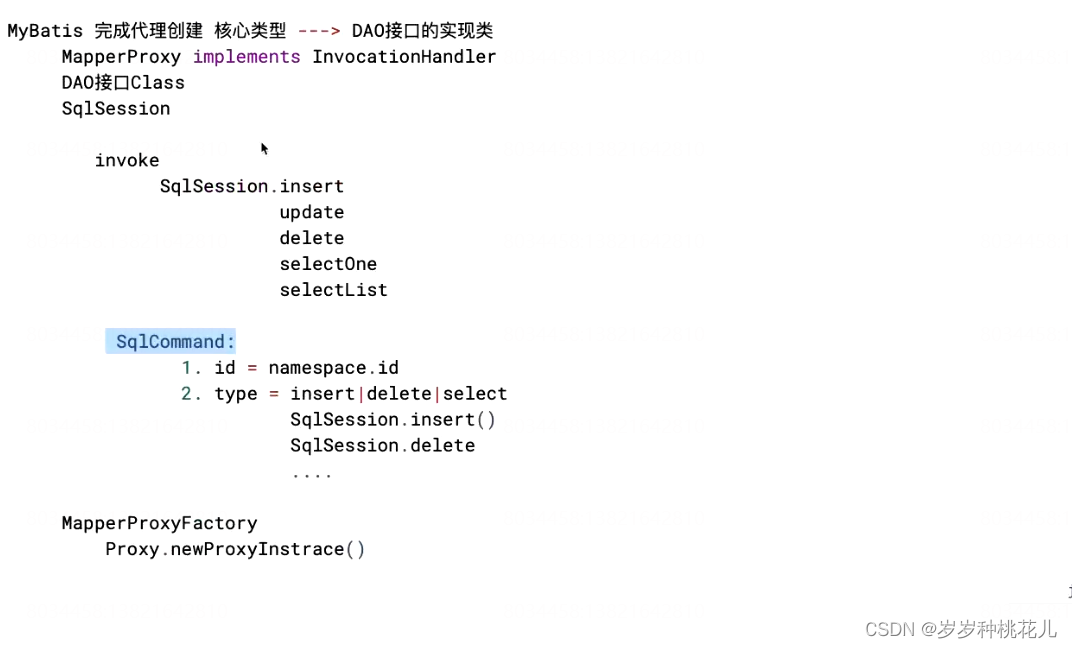
2:核心对象的拆解
1:MapMethod对象
private final SqlCommand command;
private final MethodSignature method;
public MapperMethod(Class<?> mapperInterface, Method method, Configuration config) {
this.command = new SqlCommand(config, mapperInterface, method);
this.method = new MethodSignature(config, mapperInterface, method);
}
}
MapMethod当中需要两个成员变量:SqlCommand+MethodSignature
把Method(Dao接口中的某一个方法的对象,再次包装了一层,包装成了MapMethod对象),增添了SqlCommand+MethodSignature两个成员。
2:SqlCommand对象
包含两个关键成员:
private final String name;
private final SqlCommandType type;
private final String name;
private final SqlCommandType type;
//构造方法
public SqlCommand(Configuration configuration, Class<?> mapperInterface, Method method) {
final String methodName = method.getName();
final Class<?> declaringClass = method.getDeclaringClass();
MappedStatement ms = resolveMappedStatement(mapperInterface, methodName, declaringClass,
configuration);
if (ms == null) {
if (method.getAnnotation(Flush.class) != null) {
name = null;
type = SqlCommandType.FLUSH;
} else {
throw new BindingException("Invalid bound statement (not found): "
+ mapperInterface.getName() + "." + methodName);
}
} else {
name = ms.getId();
type = ms.getSqlCommandType();
if (type == SqlCommandType.UNKNOWN) {
throw new BindingException("Unknown execution method for: " + name);
}
}
}
name是nameSpace+id,type是insert,delete,update,select
3:MethodSignature
方法的入参类型和返回值类型。对SQL入参和SQL执行后的返回值的处理提供类型机制。
到这里我们是不是就有点清晰了,Mybatis中对代理设计模式的应用是这个样子的:
1:这个流程中几个核心的成员
MappedProxyFactory:执行Proxy.newProxyInstance(ClassLoader,UserDao.class,InvocationHandler);
来创建代理对象
MappedProxy:InvocationHandler的实习类,原始功能都没有的这种代理设计模式中的功能模块,
具体进行sqlSession.select,insert,update,delete的模块
MapMethod 是对方法对象的二次封装,我们知道Mybatis中UserDao中的method,可以提供nameSpace.id嘛,
这就是他的作用。
SqlCommand:对象nameSpace.id基于构造方法,放到了name属性里边,type是method增删改查的类型描述
MethodSignature:对方法入参和方法返参的描述
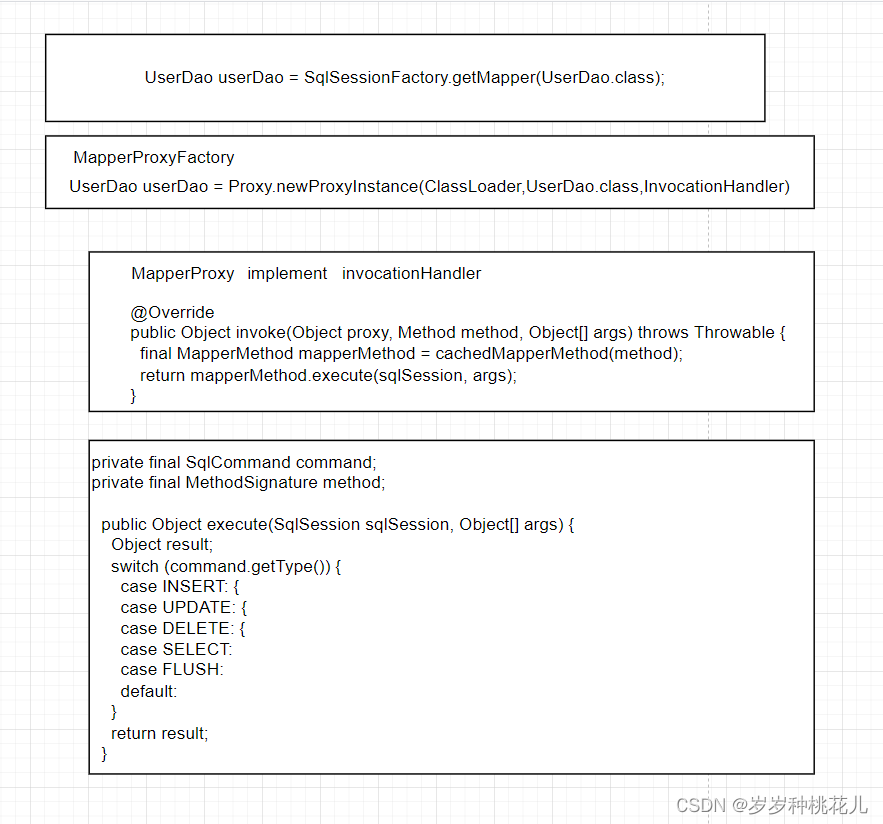
![[入门必看]数据结构1.1:数据结构的基本概念](https://img-blog.csdnimg.cn/c3dbbca0e18a4064be7335cd61b266a2.png#pic_center)
